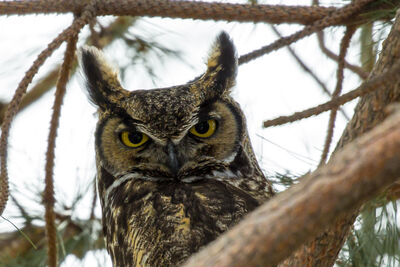What ISO Value to Choose?
Feb 4, 2012 21:03:51 #
I understand what ISO does (light sensitivity), and the downside of higher ISO values. So I know to bump up the ISO value when shooting in low light. But beyond that, knowing what value to pick is a mystery to me. 300, 500, 800, higher? How do you know what ISO value will give you the light gathering boost you need, while sacrificing the least in terms of noise, or loss of detail? Perhaps its more nuanced than this? Thanks for any advice.
Feb 4, 2012 21:12:56 #
I only have three choices, 80, 160, and 320. That I seldom pay any thought to the fact that I generally shoot at 80, tells me, that I am not working hard enough at getting optimal shots.
Feb 4, 2012 21:16:16 #
It depends on where you plan on shooting. For outside or indoor flash, I start with 200 (lowest) and go up if I need to. For indoors, I'll usually start at 400 or 800. I only go above that if absolutely necessary. The best thing is practice different situations, varying the ISO and see the differences. Make notes of what works.
The noise will be in shadows, not light areas. I've accidentally shot ISO 1600 in full sunlight and can not tell any difference from shooting 200 in the final product. There is a landscape on here where I did this - no noise at all.
The noise will be in shadows, not light areas. I've accidentally shot ISO 1600 in full sunlight and can not tell any difference from shooting 200 in the final product. There is a landscape on here where I did this - no noise at all.
Feb 4, 2012 21:18:42 #
ISO selection is entirely dependent on make & model of camera, as well as subject situation.
Testing different ISOs on same subject (which should include a dark or black background) will reveal thresholds of acceptable noise.
Personal examples:
I shoot macro at ISO 400, so that I can sync speedlight illuminated foreground with sunlight exposed background.
When I shoot aquariums, I use ISO 1600 or 2000.
When I shoot long exposure waterfalls, I shoot at ISO 100.
Testing different ISOs on same subject (which should include a dark or black background) will reveal thresholds of acceptable noise.
Personal examples:
I shoot macro at ISO 400, so that I can sync speedlight illuminated foreground with sunlight exposed background.
When I shoot aquariums, I use ISO 1600 or 2000.
When I shoot long exposure waterfalls, I shoot at ISO 100.
Feb 4, 2012 21:22:13 #
snowbear wrote:
It depends on where you plan on shooting. For out... (show quote)
Thats helpful, thanks. I guess there could also be associated advantages, e.g. allowing faster shutter speed at same aperture, right? Im thinking of bird/wildlife shooting.
Feb 5, 2012 08:15:42 #
I shoot higher ISO when shooting children to get higher shutter speed. Kids just never sit still...
Feb 5, 2012 09:05:40 #
When shooting sports inside, I crank up my Canon 60D to 6400. It has 12800 but have not tried it. The noise varies with the shot but is so much less than with Tri-X. It does not increase very much from my default ISO of 100 up to 800.
For other shooting, I adjust the ISO for the shutter and aperture being used. Then, I double it to be safe. If your camera has an automatic ISO setting, try that.
For other shooting, I adjust the ISO for the shutter and aperture being used. Then, I double it to be safe. If your camera has an automatic ISO setting, try that.
Feb 5, 2012 09:15:09 #
As you double the ISO you increase the exposure by a factor of 2 (200 to 400, 400 to 800, et.). This means you gain one f-stop or one shutter speed value . . . Until recently higher ISOs meant increasing noise; some newer sensor technologies have improved upon this somewhat but you need to test your own camera to see the actual results and what you can be satisfied with.
Some models try to achieve this solely by incorporating noise-reduction in their firmware; this doesn't work as well as in post-processing on the computer and often results in signifigant loss of detail and image "smudging". . .
Some models try to achieve this solely by incorporating noise-reduction in their firmware; this doesn't work as well as in post-processing on the computer and often results in signifigant loss of detail and image "smudging". . .
Feb 5, 2012 11:41:02 #
With compact cameras, noise is a problem quite early, from ISO 200 up. I recommend shooting at the lowest ISO when using a compact camera. That makes a compact camera very difficult to use with moving wildlife, birds in flight, aquariums, etc. because the shutter speed should usually be fairly high, and a lot of detail is desirable. With my Nikon D90, I can use ISO 1600 or even ISO 3200 with an acceptable level of noise that I can mitigate in Photoshop.
Feb 5, 2012 11:45:55 #
docrob
Loc: Durango, Colorado
globetrekker wrote:
I understand what ISO does (light sensitivity), and the downside of higher ISO values. So I know to bump up the ISO value when shooting in low light. But beyond that, knowing what value to pick is a mystery to me. 300, 500, 800, higher? How do you know what ISO value will give you the light gathering boost you need, while sacrificing the least in terms of noise, or loss of detail? Perhaps its more nuanced than this? Thanks for any advice.
I will adjust the ISO now and again when I want more light but I don't want to change the SS - mostly - honestly - it's just one of those things like choosing which shirt to wear today.....Being an old film guy I start with 100 or 125 ISO - maybe bump that to 200 - 250 maybe higher if intuition says so........there is NO correct answer NO one right setting. For me, it's intuitive or maybe laziness ........ hmmm gotta work on that.....maybe
Feb 5, 2012 11:50:47 #
I start at 160 and adjust as needed to get the best exposure, shutter speed and aperture settings.
Feb 5, 2012 11:52:33 #
globetrekker wrote:
I understand what ISO does (light sensitivity), and the downside of higher ISO values. So I know to bump up the ISO value when shooting in low light. But beyond that, knowing what value to pick is a mystery to me. 300, 500, 800, higher? How do you know what ISO value will give you the light gathering boost you need, while sacrificing the least in terms of noise, or loss of detail? Perhaps its more nuanced than this? Thanks for any advice.
Since your minimum iso yields the most desirable image under normal conditions, my short answer would be that you need to know going in what you want to achieve using the combination of aperture and shutter speed, i.e., stop action, max dof, etc. If you're shooting action, your shutter speed will need to be higher which will affect your minimum iso and cause it to have to be bumped up. If you're shooting for max dof, the same thing occurs but is more controllable in non-action shots by using a tripod for slower shutter speeds.
Once you assess what your goal is with a given shot and have your aperture and shutter speed set right to achieve your goal, if your meter says you can't get a proper exposure with your desired settings and your current iso, you start bumping it up the iso to the minimum point that will give you that exposure and that'll be your most desirable iso. That may sound oversimplified but if you don't achieve your aperture and shutter speed goals, the iso doesn't matter anyway. You then, have to determine if there's too much of a compromised results to suit your purpose. While it's not always possible, shooting in adequate light solves many of these kinds of issues. If you enjoy shooting in challenging light and therefore choose to handicap yourself in that manner, you'll likely get results that are compromised to some degree and only you can decide if you can live with those results.
If you're shooting for a more grainy or noisy effect or something blown out or too dark or whatever, let's say "artsy" then it all depends on what you're trying to achieve, once again. In this case, you'll just have to experiment with it to get what you want and hope people understand your quirkiness. :-)
Feb 5, 2012 12:42:02 #
globetrekker wrote:
I understand what ISO does (light sensitivity), and the downside of higher ISO values. So I know to bump up the ISO value when shooting in low light. But beyond that, knowing what value to pick is a mystery to me. 300, 500, 800, higher? How do you know what ISO value will give you the light gathering boost you need, while sacrificing the least in terms of noise, or loss of detail? Perhaps its more nuanced than this? Thanks for any advice.
For me I like to use the lowest ISO I can depending on the shooting situation. For wildlife and moving subject where I need a fast shutter speed I will jack the ISO up until I have a good shutter speed without losing picture quality. Doing scenery or where I want good depth of field I will do the same closing down the the aperture to where I want it without having to slow of a shutter speed that could lead to camera movement (blur) problems.
Feb 5, 2012 13:04:16 #
It's a process of elimination. Start with the aperture you need to use for the DOF that you want. Next, set a shutter speed consistent with the steadiness of the shot resulting from lens focal length and whether or not you are using a tripod. Then, set the ISO that will allow the use of the two settings above, keeping in mind that the smaller number the better as far as image quality is concerned. Give yourself a self-imposed upper limit of 400 to begin with.
I could give examples of the process that would bore you to death, but the best way to learn this stuff is by doing. Of course, these remarks apply more to manual mode than auto, or program, modes, where you may not be allowed to alter anything other than ISO.
I could give examples of the process that would bore you to death, but the best way to learn this stuff is by doing. Of course, these remarks apply more to manual mode than auto, or program, modes, where you may not be allowed to alter anything other than ISO.
Feb 5, 2012 13:16:18 #
Nevada Chuck wrote:
...Start with the aperture you need to use for the DOF that you want...Give yourself a self-imposed upper limit of 400 to begin with.
Good advice for objects not moving. What if you are shooting sports or other objects moving rapidly? What sharpness you gain with a lot of depth of field will be lost by blurring due to a too slow shutter speed.
I start with ISO 100 because, whether right or wrong, I want the highest quality, and then move up as needed. For indoor basketball, I say take no chances and shoot at 6400. I will fix the noise later.
If you want to reply, then register here. Registration is free and your account is created instantly, so you can post right away.











